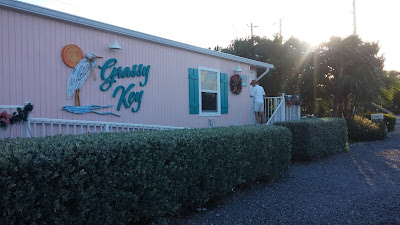 |
| Dinosaurs Galore! |
This prehistoric park is close to Cajun Palms RV Resort. We could hear dinosaur noises coming from this walk-thru park. We expected a Disney like experience where the creatures were animated and bellered like in the movies but alas none of the dinosaurs along the walkway moved or made noise. Nonetheless, it was a nice day to go for a walk along the shaded paved path in a dinosaur park.
 |
| Pterosaur - "Winged Lizard" |
The Pterosaur was a flying reptile and a carnivore. They ranged from a few inches up to 40 feet long. They walked on their elbows, by folding in their wings. They had a large brain and excellent eyesight.
 |
| Velociraptor - "Swift Plunderer" |
The Velociraptor was about the size of a really large turkey, and believed to have had feathers. They travelled in packs. They ran with their sickle-shaped toes pointed back, ready to tear apart any prey they go hold of. Their tails were inflexible and not useful as weapons, but it kept them balanced as they ran, hunted and jumped. They may have been able to run up to 40 mph on their skinny legs, but only in short bursts.
 |
| Camarasaurus - "Chambered Lizard" |
The Camarasaurus was up to 85 feet in length, up to 15 tall and up to 20 tons. It had a larger, hollow-like head in comparison to other sauropods. It had a relatively short neck and tail. It was a herbivore with teeth strong and robust indicating it may have processed food in its mouth a while before swallowing.
 |
| Tyrannosaurus Rex - "Tyrant Lizard King" |
The T-Rex, a carnivore, was up to 42 feet in length, up to 13 feet tall and up to seven tons. It has massive jaws with 50 to 60 blade-like teeth, some up to nine inches long! It could bite its prey with the force of 2000-3000 pounds of pressure. When it ran, it could go 20 mph and cover 15 feet in one step. Its arms were only three feet long with two-fingered hands, not too helpful in fighting other dinosaurs.
 |
| Styracosaurus - "Spiked Lizard" |
The Styracosaurus was a herbivore that ate ferns and plants. It was up to 17 feet long, up to six feet tall and up to three tons. Their large frills had at least six horns on them. It also had a two foot horn extending from its snout and smaller horns poking out from its cheeks. The horns were likely used to defend them from predators.
 |
| Olorotitan - "Giant Swan" |
The Olorotitan was an herbivore that ate twigs and leaves. It was up to 40 feet in length, up to 13 feet tall and weighed up to five tons. It had a relatively long neck compared to other duck billed dinosaurs. They walked primarily on two legs though it may have grazed on all four legs. It was the fastest of the hadrosaurs when on its hind legs.
 |
| Gastonia |
The Gastonia was a herbivore that ate plants, It was up to 15 feet long, up to five feet tall and weighed up to one ton. It had poor eyesight but a great sense of smell and hearing. It moved slow and probably behaved like most turtles, lying low and waiting for predators to pass. The only way to take this creature down would have been by flipping it on its back as it had a soft belly. Its head contained a mobile brain case, perhaps for shock absorbency in case of head butting in a confrontation. The Gastonia was recently discovered and named in 1998 after Rob Gaston who found the first specimen. Research is still being done on how rapidly they grew and how much they needed to eat.
 |
| In the Mouth of a Dinosaur |
The highlight was the roomful of animated dinosaurs a the end of the tour and before entering the gift shop. The tail of the dinosaur looked like it could knock the head off a really tall person.























































